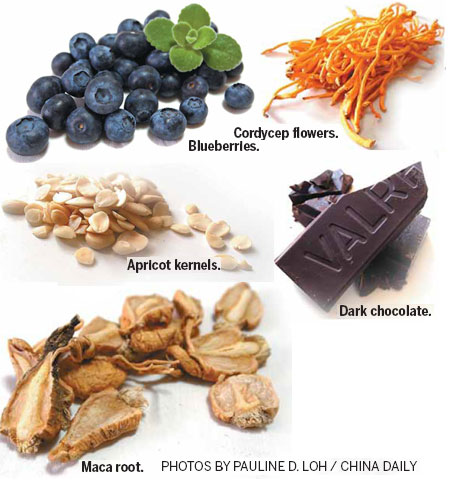Super foods: facts & fiction
Updated: 2013-02-18 14:23
By Pauline D. Loh (China Daily)
|
||||||||


Man has been looking for the elixir of eternal life for ages. The search is still on, and we now eat with more awareness than ever before. Pauline D. Loh looks at trendy super foods, and how we have lost the art of eating.
Acai berries, noni juice, sea buckthorn extract, Peruvian maca root, wolfberries, ginseng, gingko nuts, cordyceps or caterpillar fungus, black garlic, ganoderma spores - these are all exotic supplements that claim to cure you of all ills, including cancer.
They are the exotic super foods, their effectiveness often backed by claims that they have kept past civilizations hale and hearty. Many are drawn from the diets of ancient peoples like the Mayans, but just as many have been "discovered" by new Western converts to traditional Chinese medicine.
Many Chinese used to raise amused eyebrows when they saw Western friends popping pills of gingko extract and downing gallons of goji berry (wolfberry) juice.
To the Chinese, these are everyday ingredients, to be taken in moderation, as food. And to the Chinese, food is medicine and medicine is food, a philosophy remarkably similar to that of the ancient Greek physician Hippocrates. (Moderation is part of the prescription. Too much gingko is actually toxic, as every Chinese child has been taught.)
That's the difference between Western and Chinese medicine. One cures the symptoms, while the other seeks out the root of the illness and believes a balanced body is the answer to good health.
That does not mean the Chinese do not believe in health tonics, supplements and super foods. They just have their own lists, mostly herbal, but sometimes animals and minerals.
We really don't know when we started justifying every bite we ate. In times past, mothers from both hemispheres and all longitudes urged their children to "eat more spinach because it's good for you", often pointing to the TV and Popeye the Sailor man as animated proof.
In these days of New Age nutrition, mothers still try to persuade their kids to eat more spinach, only they'll be more likely quoting liberally from online surveys and nutrition charts.
Not that it works any better than Popeye in persuading the young ones to down the dark green stuff.
As we grow older, though, the search for health and the panacea for urban ills and physical discomforts take over. We'll be exploring the latest health supplements, combing through a humongous overload of information from e-mails and Web links sent by well-meaning friends, relatives, acquaintances and online marketers.
There are plenty of health fads to follow, some being rather edgy, and others demanding great discipline over long periods of time
And so, there are the 90 raisins soaked in vodka to be administered three a day for 30 days for three years, or eggs and black beans marinated in black rice vinegar, or donkey glue dissolved in yellow rice wine - all to be taken faithfully until presumably you reach the ripe old age of 90 and you no longer have the mortal need for daily boosters.
Then there are the lists of super foods periodically put out by the best-known authorities in health and fitness, ranging from the American doyen of wholesome living, Oprah Winfrey, to her protege and current Time magazine health columnist Dr Oz.
There are lots of self-proclaimed experts as well, all gaining instant fame through the mighty machines of Twitter and Sina Weibo.
But if we look a little closer at these famous lists, take away the slightly bizarre and rare exotic cure-alls like chia seeds, acai juice, quinoa, twig tea and so on, you get the garden variety staples that normally inhabit the nutrition pyramid.
Whole grains, green leaves, orange vegetables like carrots and pumpkins, nuts, beans and eggs are recurring items on the lists of super foods put out by Oprah, Dr Oz, Joy Bauer and Woman's Day, for example.
Salmon, or other oily fishes, and sardines also inhabit the lists for their calcium and Omega-3 oil content.
It is no surprise that many "Chinese" products have made the lists, too.
Pu'er tea, green tea, red or adzuki beans, mung bean sprouts, bok choy, wolfberries, ginseng, cordyceps, fleece flower root, astragalus root, pomegranates and apricot kernels all look more at home in Chinese grocery or pharmaceutical stores, but they seem to have found a place in the supplement boutiques in the West as "super foods".
But let's get back to the basics and look at the definition of the term. There are several, and readers can take their pick.
Super foods are "nutritional powerhouse foods loaded with nutrients crucial to a healthy, long life", according to www.superfoodsrx.com, which goes on to define the principles that separate super foods from well, ordinary food.
Super foods are those that constantly show up in the diets of the world's healthiest populations, from data collected by highly respected studies done by institutions such as American Heart Association, the American Cancer Society, and the National Cancer Institute (US).
Super foods are whole foods, that is, food that comes in natural form, being unprocessed or minimally processed, so that "none of their nutritional characteristics have been intentionally modified".
Based on these classifications, we come full circle to the food pyramid and those familiar homilies that our mothers and grandmothers have been nagging us about.
Don't push aside the broccoli and Brussels sprouts. Eat your carrots. Finish your oatmeal or rice, depending on which hemisphere you come from. And most of all, avoid over-processed fast foods.
Super foods, it seems, are just ordinary wholesome foods given modern packaging, but they are also grim reminders that we have been so seduced by fast food and convenience foods that we have forgotten how to eat.
Mother was right. Eat your spinach.
Contact the writer at paulined@chinadaily.com.cn.
(China Daily 02/17/2013 page1)

 In Photos: 7.0-magnitude quake hits Sichuan
In Photos: 7.0-magnitude quake hits Sichuan
 Li Na on Time cover, makes influential 100 list
Li Na on Time cover, makes influential 100 list
 FBI releases photos of 2 Boston bombings suspects
FBI releases photos of 2 Boston bombings suspects
 World's wackiest hairstyles
World's wackiest hairstyles
 Sandstorms strike Northwest China
Sandstorms strike Northwest China
 Never-seen photos of Madonna on display
Never-seen photos of Madonna on display
 H7N9 outbreak linked to waterfowl migration
H7N9 outbreak linked to waterfowl migration
 Dozens feared dead in Texas plant blast
Dozens feared dead in Texas plant blast
Most Viewed
Editor's Picks

|

|

|

|

|

|
Today's Top News
Live report: 7.0-magnitude quake hits Sichuan, heavy casualties feared
Boston suspect cornered on boat
Cross-talk artist helps to spread the word
'Green' awareness levels drop in Beijing
Palace Museum spruces up
First couple on Time's list of most influential
H7N9 flu transmission studied
Trading channels 'need to broaden'
US Weekly

|

|







